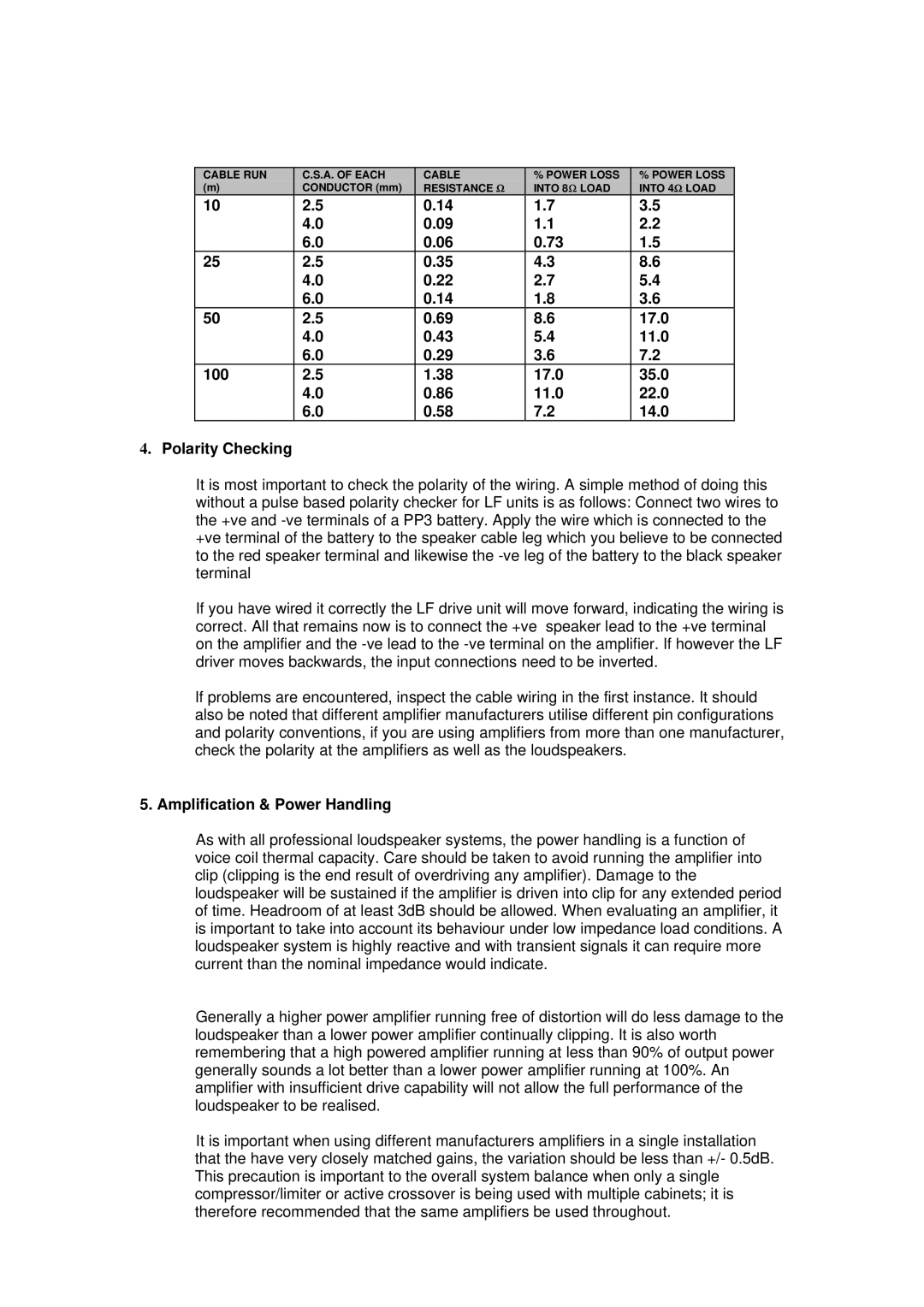CABLE RUN | C.S.A. OF EACH | CABLE | % POWER LOSS | % POWER LOSS |
(m) | CONDUCTOR (mm) | RESISTANCE Ω | INTO 8Ω LOAD | INTO 4Ω LOAD |
10 | 2.5 | 0.14 | 1.7 | 3.5 |
| 4.0 | 0.09 | 1.1 | 2.2 |
| 6.0 | 0.06 | 0.73 | 1.5 |
25 | 2.5 | 0.35 | 4.3 | 8.6 |
| 4.0 | 0.22 | 2.7 | 5.4 |
| 6.0 | 0.14 | 1.8 | 3.6 |
50 | 2.5 | 0.69 | 8.6 | 17.0 |
| 4.0 | 0.43 | 5.4 | 11.0 |
| 6.0 | 0.29 | 3.6 | 7.2 |
100 | 2.5 | 1.38 | 17.0 | 35.0 |
| 4.0 | 0.86 | 11.0 | 22.0 |
| 6.0 | 0.58 | 7.2 | 14.0 |
4.Polarity Checking
It is most important to check the polarity of the wiring. A simple method of doing this without a pulse based polarity checker for LF units is as follows: Connect two wires to the +ve and
If you have wired it correctly the LF drive unit will move forward, indicating the wiring is correct. All that remains now is to connect the +ve speaker lead to the +ve terminal on the amplifier and the
If problems are encountered, inspect the cable wiring in the first instance. It should also be noted that different amplifier manufacturers utilise different pin configurations and polarity conventions, if you are using amplifiers from more than one manufacturer, check the polarity at the amplifiers as well as the loudspeakers.
5. Amplification & Power Handling
As with all professional loudspeaker systems, the power handling is a function of voice coil thermal capacity. Care should be taken to avoid running the amplifier into clip (clipping is the end result of overdriving any amplifier). Damage to the loudspeaker will be sustained if the amplifier is driven into clip for any extended period of time. Headroom of at least 3dB should be allowed. When evaluating an amplifier, it is important to take into account its behaviour under low impedance load conditions. A loudspeaker system is highly reactive and with transient signals it can require more current than the nominal impedance would indicate.
Generally a higher power amplifier running free of distortion will do less damage to the loudspeaker than a lower power amplifier continually clipping. It is also worth remembering that a high powered amplifier running at less than 90% of output power generally sounds a lot better than a lower power amplifier running at 100%. An amplifier with insufficient drive capability will not allow the full performance of the loudspeaker to be realised.
It is important when using different manufacturers amplifiers in a single installation that the have very closely matched gains, the variation should be less than +/- 0.5dB. This precaution is important to the overall system balance when only a single compressor/limiter or active crossover is being used with multiple cabinets; it is therefore recommended that the same amplifiers be used throughout.
